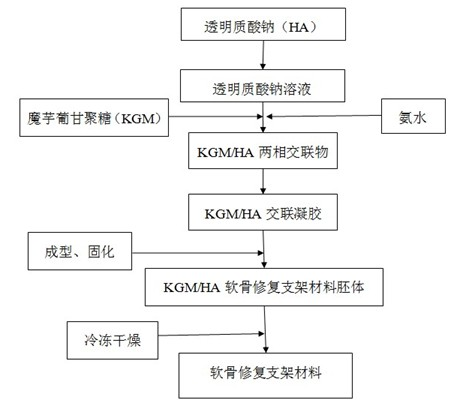Sodium hyaluronate and KGM porous bracket material and method for preparing same
A technology of konjac glucomannan and sodium hyaluronate, applied in the field of biomedical materials, can solve problems such as high cost and unsatisfactory performance of scaffold materials, and achieve the effects of uniform distribution, favorable wound healing, and good growth and proliferation state.
- Summary
- Abstract
- Description
- Claims
- Application Information
AI Technical Summary
Problems solved by technology
Method used
Image
Examples
Embodiment 1
[0024] Embodiment 1: It is composed of sodium hyaluronate and konjac glucomannan, and the mass ratio of sodium hyaluronate to konjac glucomannan is 1:100.
[0025] see figure 1 , the preparation method of the sodium hyaluronate and konjac glucomannan porous scaffold material is:
[0026] (1) According to the mass ratio of sodium hyaluronate and water of 1:2000, dissolve sodium hyaluronate in water, stir it to fully dissolve, and then add alkaline solution into the solution; the concentration of alkaline solution is 0.1vol %%NH 3 ·H 2 O solution, the volume ratio of alkaline solution to water is 1:267.
[0027] (2) Cross-linking: according to the mass ratio of sodium hyaluronate to konjac glucomannan of 1:100, konjac glucomannan is added to the product obtained in step (1), and stirred until it is in a gel state;
[0028] (3) Seal the material obtained in step (2) and mature it in a water bath at a temperature of 70°C for 24 hours, take out the material, and then lower the ...
Embodiment 2
[0029] Embodiment 2: It is composed of sodium hyaluronate and konjac glucomannan, and the mass ratio of sodium hyaluronate to konjac glucomannan is 1:80.
[0030] see figure 1 , the preparation method of the sodium hyaluronate and konjac glucomannan porous scaffold material is:
[0031](1) According to the mass ratio of sodium hyaluronate and water of 1:100, dissolve sodium hyaluronate in water, stir it to fully dissolve, and then add alkaline solution into the solution; the concentration of alkaline solution is 0.8vol %% NaOH solution, the volume ratio of alkaline solution to water is 1:5000.
[0032] (2) Cross-linking: according to the mass ratio of sodium hyaluronate to konjac glucomannan of 1:80, konjac glucomannan is added to the product obtained in step (1), and stirred until it is in a gel state;
[0033] (3) Seal the product obtained in step (2) and mature it in a water bath at a temperature of 50°C for 12 hours to take out the material, then lower the temperature of...
Embodiment 3
[0034] Embodiment 3: It is composed of sodium hyaluronate and konjac glucomannan, the mass ratio of sodium hyaluronate and konjac glucomannan is 1:5.
[0035] see figure 1 , the preparation method of the sodium hyaluronate and konjac glucomannan porous scaffold material is:
[0036] (1) According to the mass ratio of sodium hyaluronate and water of 1:20, dissolve sodium hyaluronate in water, stir to make it fully dissolved, and then add alkaline solution into the solution; the concentration of alkaline solution is 1vol% % NH 3 ·H 2 O solution, the volume ratio of alkaline solution to water is 1:100.
[0037] (2) Cross-linking: according to the mass ratio of sodium hyaluronate to konjac glucomannan of 1:5, konjac glucomannan was added to the product obtained in step (1), and stirred until it was in a gel state;
[0038] (3) Seal the product obtained in step (2) and mature it in a water bath at a temperature of 90°C for 48 hours, take out the material, and then lower the tem...
PUM
| Property | Measurement | Unit |
|---|---|---|
| pore size | aaaaa | aaaaa |
| compressive stress | aaaaa | aaaaa |
| porosity | aaaaa | aaaaa |
Abstract
Description
Claims
Application Information
 Login to View More
Login to View More - R&D
- Intellectual Property
- Life Sciences
- Materials
- Tech Scout
- Unparalleled Data Quality
- Higher Quality Content
- 60% Fewer Hallucinations
Browse by: Latest US Patents, China's latest patents, Technical Efficacy Thesaurus, Application Domain, Technology Topic, Popular Technical Reports.
© 2025 PatSnap. All rights reserved.Legal|Privacy policy|Modern Slavery Act Transparency Statement|Sitemap|About US| Contact US: help@patsnap.com


